Have you ever thought about the number of hours you spend communicating at work? From emails and instant team messages to phone calls and video conferences, it adds up pretty quickly. In fact, research shows that, on average, we spend between 50% and 80% of our workday communicating.
In line with this, organizational communication plays one of the key roles in their overall success.
Lateral communication, as one of the three most used communication types at the workplace, seems to be given unrightfully less emphasis in workplace communications discussions. Most often, organizations are more focused on how to facilitate better top-down and bottom-up internal communication, which often leaves little to no bandwidth to work on lateral communication.
However, with recent organizational trends aiming to flatten the hierarchical pyramid, we’re seeing more organizations acknowledging the importance of lateral communication and working towards improving it.
If you too are contemplating optimizing your organization’s lateral communication, be sure to read on. We’re breaking down lateral communication at the workplace with examples and actionable tips on how to improve this vital segment of your organizational collaboration.

Table of Contents
What is lateral communication?
Lateral communication — in the broadest sense — is the communication flow between peers, members of a community, or coworkers belonging to the same hierarchical level. Essentially, any type of exchange (formal or informal) aiming to solve a problem, access information, achieve a common goal, or discuss common interests between same-level participants is considered lateral communication.
What is lateral communication in an organization?
In terms of organizational context, lateral communication takes on a more specific definition. Lateral communication in an organization refers to the interaction between individuals and groups on the same hierarchical level in an organization. As opposed to other, less formal communication settings, lateral communication at the workplace implies a more focused objective.
Usually, the flow of messages between groups or individuals occupying the same functional areas in an organization is carried out with a clear purpose — to obtain information, exchange ideas, coordinate tasks, achieve common goals, or resolve conflicts.
However, as lateral communication can include an exchange between members of the same team, it can also have a less formal tone and a more flexible structure. It doesn’t necessarily need to have a clear business objective, other than building better connections between coworkers in remote teams, for example.
Lateral vs. downward vs. upward communication
Before we get into a more detailed analysis of lateral communication, let’s first make a comparison between the different types of internal communication to better understand the role of lateral communication in an organization.
First, let’s start from a broader category i.e. — the difference between horizontal and vertical types of internal communication.
While vertical communication refers to the flow of information across the hierarchical ladder, horizontal communication implies the exchange between individuals or teams belonging to the same organizational level.
↔️ Lateral communication, therefore, becomes synonymous with horizontal communication type as it takes place between people on the same hierarchical level.
When compared to upward or downward communication, it often implies a quicker, more immediate exchange — in addition to often being more efficient than the other two.
Lateral communication also often involves a less formal style than vertical communication types.
⬇️ Downward or top-down communication, on the other hand, refers to the vertical process of information exchange that starts from the upper level and ends when the information reaches the lowest member of the hierarchical ladder.
⬆️ Upward or bottom-up communication follows the opposite direction. It is a vertical communication flow that begins at the lower level of the organizational hierarchy and ultimately reaches the top-level executives and decision-makers.
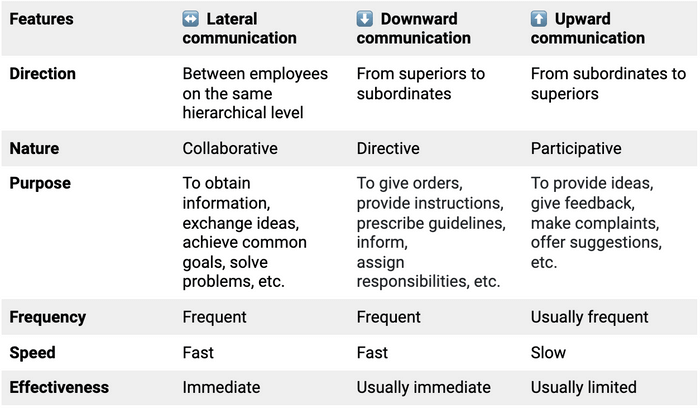
Examples of lateral communication
Let’s get a closer look at lateral communication using some common workplace examples.
🔶 Lateral communication across teams
Successful cross-department collaboration depends on effective communication between members of each unit. Lateral communication, in this instance, takes place each time members of different teams communicate with people from other departments that share the same place on the hierarchical ladder. Any time, for example, a sales team receives a complaint from a client and pings the development team in a business messaging app such as Pumble, we are witnessing a cross-team lateral communication taking place.
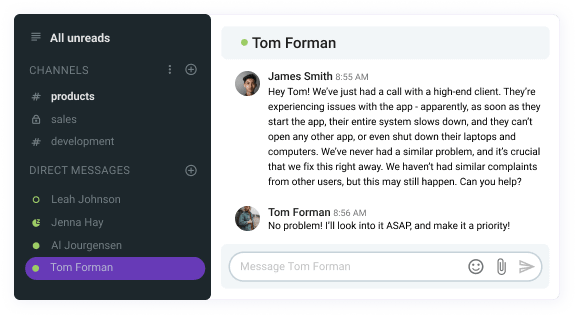
🔶 Lateral communication between members of the same team
This is one of the most common examples of lateral communication in the workplace. After all, workplace communication between members of the same team takes place almost all the time. Whether they are exchanging ideas, brainstorming, or sharing relatable industry memes, this type of exchange makes up the majority of internal communication. At the same time, communication between team members carries plenty of benefits to teamwork and team spirit, better collaboration and productivity, and overall team connectivity.
Essentially, lateral communication between members of the same team takes place, for example, every time your teammate posts about their weekly progress on the project you’re working on and the entire team jumps in to cheer them on.

Advantages of lateral communication at work
Apart from boosting productivity and collaboration across teams and departments within an organization, efficient lateral communication carries plenty of other benefits to a company. As it involves members on the same organizational level, horizontal interaction is usually much quicker, less formal, and ultimately, more efficient than upward or downward communication.
Let’s get a closer look at some of the most significant advantages of lateral communication at work.
Lateral communication is time-efficient ⏱️
As companies are looking for ways to answer the demands of fast-paced global markets, quick and time-efficient internal communication becomes the absolute imperative. Problem-solving, a quick exchange of cross-department information, and time-efficient knowledge sharing between members at the same organizational level, thus become some of the key determiners of a company’s success.
Lateral communication is more direct 📲
Unsurprisingly, most employees would opt for a more direct style when communicating with a group that occupies the same hierarchical level. For example, we all feel more comfortable cutting to the chase when asking a teammate to help us find the right resource for the project we’re working on, as opposed to crafting a message or an email to our team manager. The immediate quality of lateral communication further improves collaboration and enhances connectivity and team spirit within an organization.

Lateral communication often produces higher-quality interaction 👌
As it occurs directly between people working on the same hierarchical level in an organization, lateral communication promises a better quality of information exchange almost by default. When all participants in a conversation share similar knowledge, communication style, and industry language and terms, the exchange is bound to produce more value.
For example, a direct conversation between managers of different marketing departments who are in sync in terms of all the important communication criteria almost by definition guarantees the maximum quality of information exchange.
Lateral communication is more efficient ✅
The efficiency of lateral communication ties in perfectly with the previous points. Being quick, more immediate, and producing higher-quality exchange, lateral communication thus promises better overall efficiency.
This is especially significant for tech companies striving to achieve utmost productivity and product innovation through changes in leadership and management.
In his opinion piece for Forbes, Steve Denning states that, as opposed to the traditional economy that relied on top-down communication, the Creative Economy thrives due to a shift towards lateral conversations — where the role of the leader is to “inspire people across organizational boundaries to work together on common goals.”
Ultimately, as employees develop the skills of efficient lateral communication and learn to better express their views and opinion, it drives better employee performance.
Challenges of lateral communication at work
Apart from the considerable advantages lateral communication produces for the overall organizational success, it’s still not devoid of potential challenges, especially when not orchestrated properly within an organization.
Let’s break down some of the most common disadvantages of lateral communication to help you build a challenge-proof lateral communication culture in your organization.
Potential competitiveness between co-workers 🏃♀️🏃
In teams with highly competitive employees, constructive lateral communication will most certainly take a hit. When employees are solely focused on achieving their individual goals, they are more likely to start exhibiting toxic behavior and poor communication practices.
They may start to withhold information, avoid answering questions, skip meetings, and fail to follow the generally accepted principles of team communication. This is ultimately how the silo mentality is formed, and in this case, each team member acts as a separate unit, which then hinders the entire team’s productivity and collaboration.
However, in some cases, these challenges in team communication may resemble teammate competitiveness, yet they may stem from an organizational flaw.
According to Lisa Brown — HR expert at HR Collaborative — lateral communication suffers when there’s a lack of consensus on the priority, timing, and roles in the communication within the organization.
“In some organizations, employees are afraid to communicate across departments without first filtering through their manager in fear that they will be viewed as being insubordinate or doing their boss’ job.”
A territoriality mindset 🗺️
Similar to the previous challenge, a territoriality mentality can severely damage lateral communication at the workplace. When teams operate in silos, it can be quite challenging to shift to more open, and collaborative lateral communication.
Lisa Brown finds this mentality to originate at the leadership level where often “managers hold tight reigns on information and are protective or territorial over their respective work areas.”
Apart from damaging cross-team communication and collaboration, the territoriality mindset further limits the employee’s overall motivation to get involved in any conversations outside their immediate areas.
How to improve lateral communication at work?
If you’ve identified one or all of these workplace communication challenges in your organization it might be time to develop a better lateral communication framework. In addition to putting a stop to some toxic communication practices, effective workplace communication enhances productivity and collaboration, and improves problem-solving, conflict resolution, and drives employee engagement. Let’s examine some of the tried and tested solutions to mastering lateral communication at the workplace.
Assess your workplace culture
Although most common, the mentioned lateral communication challenges are not universally applicable to each organization. In your company, for example, things can run pretty smoothly in terms of willingness to share information across departments, but the problem might be in the lack of opportunities for these conversations to take place.
To pinpoint major challenges and opportunities for improvement in lateral communication, consider starting from the culture analysis.
Pay special attention to how teams communicate and interact to be able to identify potential problems.
Additionally, it’s a good idea to assess the onboarding process as well, as it is the first point of reference for employees. And in most cases, onboarding is where new employees will draw from when it comes to internal communication practices in the organization. Emma Lindgren, a communications strategist at Whippy — a company that specializes in digital onboarding — shares a similar opinion:
“We’ve identified that onboarding new employees is a “window” usually missed out on when creating a cross-function collaboration culture at work. During the first three months, employers can train new employees and foster a behavior towards reaching out to colleagues across functions and markets to tackle challenges and innovate.”
Finally, make sure to check the behavior of leaders and decision-makers as they act as role models for other team members. Lindgren stresses the pivotal role leaders play in the way lateral communication and collaboration are formed within an organization:
“Management teams and senior leaders need to role model behavior linked to collaboration with other teams and departments rather than building isolated teams.”
Performing regular culture surveys will help you analyze potential challenges and use the information to improve lateral communication by encouraging teamwork through awarding team success as opposed to individual performance, for example.
Perform a lateral communication survey
Once you’ve identified potential causes for poor lateral communication, it’s time to assess the actual quality of communication between departments and team members and find opportunities for improvement.
However, this time, consider opting for a feedback-based approach. Perform an anonymous survey to gain employee insight and opinion on the matter. This approach allows you to directly tap into the main metrics and get an objective assessment of your lateral communication quality directly from the main participants and interest groups — employees.
When crafting a survey, be sure to form clear questions that evaluate quality, transparency, style, and the volume of horizontal communication.
In addition, consider assessing the efficiency of communication channels and tools, as well as the opinion on the willingness of teammates to collaborate. Lindgren shares the same perspective on the importance of collecting data:
“[…]you need to measure to be able to improve. Keep track, and let data help you understand the collaboration climate internally.”
Create a clear lateral communication system
Once you’ve got all the data, use it to craft a more informed user-centric communication plan that will better serve the overall organizational collaboration and goals.
Brown sums up the most important points to consider when crafting a solid lateral communication system:
“To improve upon the challenges identified, I would encourage an organization to determine what information needs to be shared, by whom, the timing of the communication, and the platform as well as empowering employees to take ownership of the communication and leverage the tools available to do so.”
Let’s go over some of the key points and techniques you can use to craft a productive lateral communication system in your organization.
Define quantity and quality guidelines
Ever had to fight the urge to respond to a message shared by a coworker in a #random channel in the company business chat app?
On one hand, you know it’s important to stay connected to your teammates and engage in conversations.
Yet, you know this little piece of irrelevant information may mess up your entire workflow.
When working to encourage internal communication, companies fail to clearly communicate quality and quantity guidelines. This can mislead employees into thinking that more communication is always better, which is actually just one of the long-held communication myths that continue to harm internal communications.
The lack of proper strategy defining the quality, relevance, and timing of information sharing across same level individuals and groups in an organization can potentially cause harmful scenarios such as information overload.
To avoid these communication problems, consider crafting a detailed guide that defines all the key metrics of healthy lateral communication, encourages productive collaboration and overcommunication, and improves communication efficacy.
Suggest uniform communication styles
The success of workplace communication is largely determined by the communication styles of the people participating in the conversations. Just because your team speaks the same language, doesn’t necessarily mean that the optimal level of understanding and clarity is reached. With the aforementioned competitiveness adding to the problem, people can resort to some less ideal communication styles to reach their personal goals. Let’s not forget that a staggering 86% of employees, executives, and educators blame most workplace failures on poor internal communication.
To prevent manipulative or aggressive communication from damaging relationships and productivity, consider adopting uniform communication styles as a general rule in workplace communication in your organization.
One of the best options here is assertive communication as it promotes clarity, reduces misunderstanding, and promotes a healthier workplace culture.
Additionally, to avoid misunderstandings and promote cross-team sharing and collaboration, instruct employees to simplify their vocabulary — i.e. use less technical terms when communicating with people from different departments who might not be familiar with the specific terminology.
Use a centralized communication channel
Teams experiencing challenges in lateral communication can usually determine multiple factors that damage productive and effective communication at the workplace. And, in most cases, using multiple communication channels isn’t really doing any service to any of these organizations. Quite the opposite — this practice only amplifies problems in miscommunication, team silos, and territoriality.
The solution might lie in using a centralized communication channel. More specifically — a single business messaging app that supports multiple channels and conversation levels, as well as diverse functionalities for remote and in-office communication.
Let’s get a closer look at how a centralized communication app can improve lateral communication at the workplace — using the business messaging app Pumble to illustrate our points.
Streamline all communication — Pumble allows easier access to all teams across all company conversations. Furthermore, it allows more efficient conversations with features like mentions for urgent conversations.
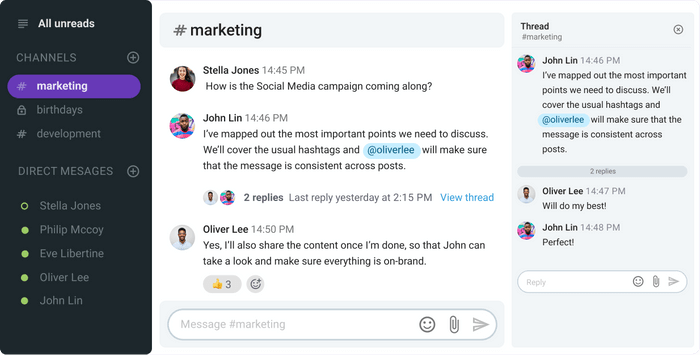
Organize conversations by categories for teammates, managers, or cross-department projects, for example, using Pumble channels, DMs, or groups.
Boost collaboration by 28% with seamless search and easy file sharing.
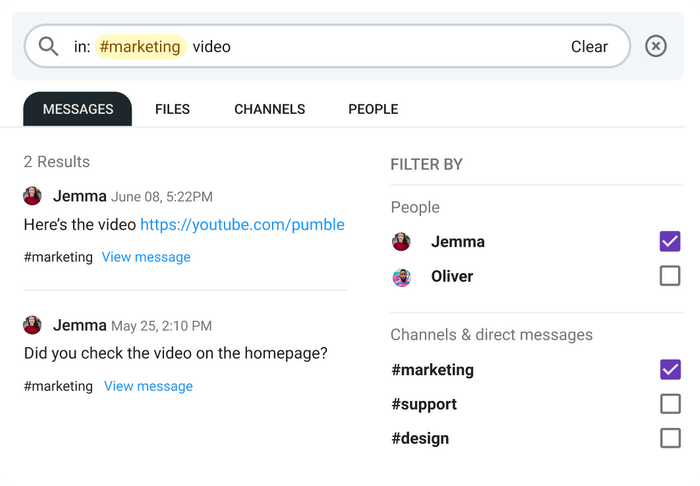
Encourage employees to communicate more. Motivate employees to engage in lateral communication with a user-friendly interface and flexibility, which is especially valuable in remote work arrangements. Remote workers prefer to communicate via business communication platforms. According to a Pew Research Center study, 57% of remote workers like using business messaging apps.
Better support asynchronous communication for teams working across time zones with availability status options meant to help teams communicate off-time. You can also use mentions to expedite urgent conversations.
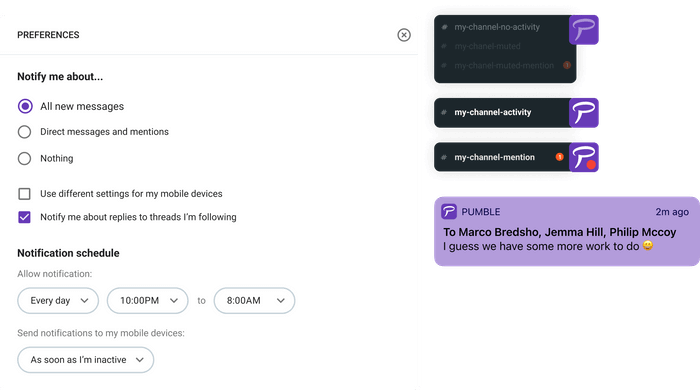
Wrapping up: Lateral communication requires a company culture adaptation
As opposed to vertical communication models, lateral communication presents a unique set of challenges for the existing, potentially limited structures to properly implement it. As such, it requires all hands on deck to carry out the changes needed to shift towards a more flexible company culture that better supports lateral communication and collaboration. Use the steps provided in this article to analyze and improve the state of lateral communication in your organization.




